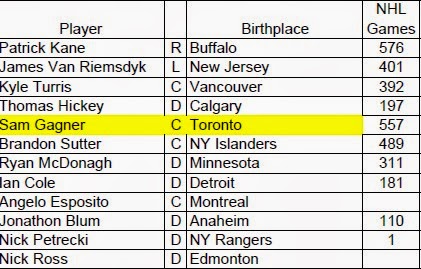In my previous article (How to Rectify the NHL Draft Lottery) I detailed a proposal on how
to rectify what I see as the issues with the current NHL Draft Lottery. My
proposal was to give each NHL team what I call a Protected Draft Territory or
P.D.T.
In that previous article, I listed the initial misgivings
I had with my proposal – that the NHL’s Canadian teams would inherit an unfair
advantage because of their proximity to large amateur hockey leagues and that
the NHL’s U.S. teams would be unfairly penalized because of their perceived
lack of amateur hockey leagues in their vicinity. But as you will see in this
article, the application of the P.D.T. to the year 2014 did not result in any discernible
level of advantage or disadvantage.
At this point I’ll quickly rehash the three P.D.T. rules that
I applied to the 2014 NHL Entry Draft:
- A player’s birth place,
not his last amateur hockey team before becoming eligible for the NHL
Entry Draft, determined which P.D.T., if any, the player would be eligible
for.
- Where more than one NHL
team shares a natural territory (such as a province or a state), how close
a player’s birth place is to an NHL team determined which P.D.T. the
player would be eligible for.
- As each player was removed
from the original entry draft because of designation under the P.D.T., the
players below the removed player were moved up in the draft order. This
seems rather arbitrary. But without any knowledge of what each team would
have drafted had the player they originally drafted not been available, it
seems like a fair compromise. So, for example, if the first player chosen
in the original entry draft had been designated under the P.D.T., the
second player chosen in the original entry draft was moved up to the first
player chosen in the revised entry draft.
Since 2014 was another good year for talent in the Entry
Draft, the application of the three simple rules above may have somewhat altered
the recent history of the NHL as we know it. A few good players would have gone
to different teams and helped build them into solid contenders and perhaps
eventual Cup winning teams.
Table 1 below is actually two tables in one. The first
six columns represent how the original NHL Entry Draft played out. The second
six columns represent how a revised NHL Entry Draft might have transpired after
the application of the P.D.T. rules.
Table 1.
Even though it is the most recent draft, there are more
than a few recognizable names from the original 2014 Entry Draft. For example, Aaron
Ekblad, Sam Reinhart, Leon Draissaitl, Sam Bennett, William Nylander, Nick
Ritchie, Brendan Perlini, Dylan Larkin, David Pastrnak, and Josh Ho-Sang.
Via designation of their
P.D.T., the Maple Leafs would have been able to continue to solidify their
depth down the middle and select another player who has shown every indication
of turning out to be a good NHL player – Sam Bennett.
With three of the top four original picks eligible for designation
under the P.D.T., the picks in the revised draft would have been very different.
For example, Leon Draissaitl, Nick Ritchie, Brendan Perlini, Dylan Larkin, David
Pastrnak, and Josh Ho-Sang would have all been drafted by different teams.
By looking closely at Table 1 above, we can see the players
in Table 2 below are the players from the first round of the draft who would
have been eligible for designation under the P.D.T. rule and therefore would
have started their careers with and played for different teams:
Table 2.
The casual fan, looking at the names from Table 2, would find
the list to have fewer recognizable names than less recognizable names but this
is to be expected as this draft was the most recent.
From that same list of names above, the one having the
most interest for Maple Leafs fans would, of course, be Sam Bennett.
As was the case for the revised Entry Drafts starting from
the year 2000, the revised Entry Draft for 2014 provides and will provide many questions
for endless speculation, discussion, and debate.



















